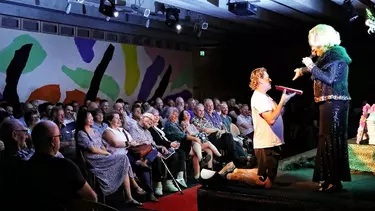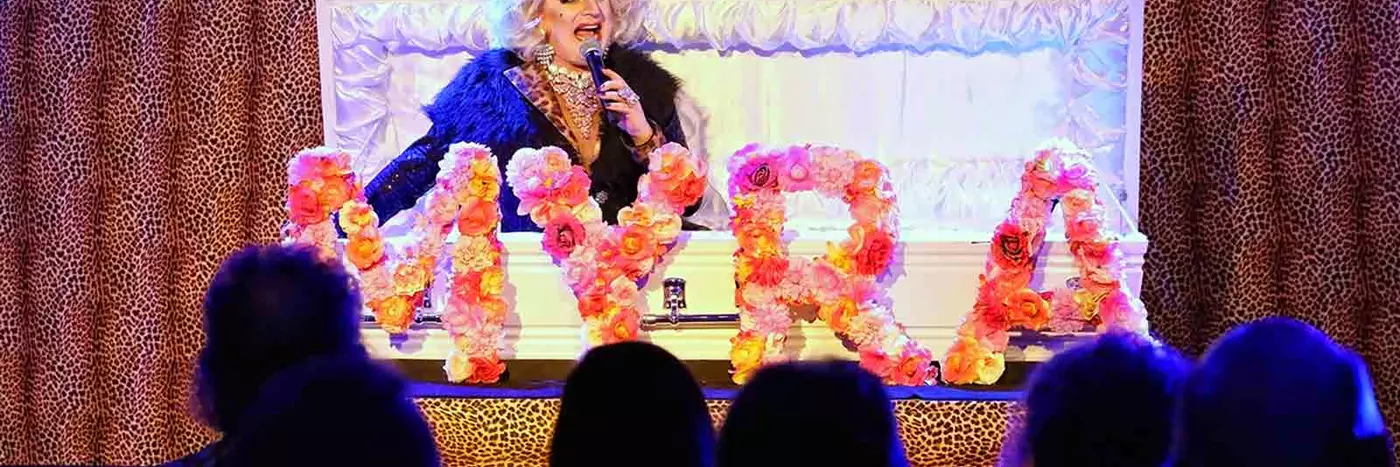The making of a comedy persona
Myra DuBois brings laughter back from the grave
Ihave always been a show off. Trying to remember how I learned to play dress-up is like trying to recall how I learned to walk and talk. Being an only child and raised by a single mother in UK public housing, I didn’t have a parent of each binary gender to work from, but children don’t care about gender until they’re taught it. From my earliest memories I was decorating myself in the discarded clothing of the adults that surrounded me – my mother’s fur coat (a personal favourite, kept under her bed, a glamorous relic from her pre-parent days) and my grandfather’s trilby (which, when teamed with a magnifying glass and his wax jacket, would transform me into Sherlock Holmes).
Fast forward and I became a university dropout with a retail job at Marks and Spencer. My friend Richie and I had taken to getting drunk with great enthusiasm and did it as often as we could. We were also into dressing up, inspired by the film Party Monster and a vague awareness of the electro/nu-rave scene that was happening in London. One night we decided we were going out in wedding dresses but we couldn’t find them in our size so we settled on the next best thing; notorious serial killers.
Richie chose Rose West, I opted for Myra Hindley. We rustled round the vintage and fancy dress shops and, once happy with our purchases, out we went. The night is now a vague recollection of vodka infused blurs, but the nicknames stuck. He called me Myra, I called him Rose. We would ask each other how the other was doing, and slowly built up fictitious narratives for these women which quickly separated themselves from their real life, infanticidal counterparts. They were sisters. Rose, it transpired, was a stay-at-home frump whilst Myra was the bottle blonde good-time-gal who spent most of her time at the Working Men’s Club (where the real life Gareth also worked as a glass collector and later, barman). Myra, it turned out, was a bit of a singer not unlike the singers I saw myself working at the club every night, and enjoyed the company of men, and leopard print. Looking back, both Myra and Rose were a real patchwork of the women I’d worked alongside and saw drinking in the club.
If we move forward two more years, I’m 21 and at my new university (about to drop out, but I didn’t know this at the time), when I saw an advert for an open mic night at Madam JoJos, a nightclub in Soho with a long history of drag acts and burlesque performers (now sadly closed). I’d suspected that this ‘Myra’ character had legs (that would look excellent in fishnets) and so I booked myself in for a slot and wrote ten minutes of material. I decided to keep the name Myra. I liked the unsavoury connotations. To contrast this, I felt a showbiz surname was in order. I’d been listening to the soundtrack to the Mel Brook’s musical The Producers and had misremembered the character of ‘Rodger DeBris’ as ‘Rodger DuBois’, and so DuBois it was. Many people assume that DuBois came from Tennessee Williams’ A Streetcar Named Desire but I’m afraid the etymology of Myra’s surname is nowhere near that literary. It was simply the result of a brain fart. Sorry Myra!

I’ve given a detailed description of Myra’s genesis to illustrate why I’m always quick to deplore her ever being referred to as a “drag queen”. I never wanted to be a drag queen. I enjoyed it! Goodness me, did I enjoy it! I wore my Priscilla VHS tape out. And as for Rocky Horror? It raised me in my teens when I was an isolated closeted queer kid. But a drag queen acknowledges the gender of the performer. Myra is a character, a character that is played by an actor, which requires a suspension of disbelief. The audience knows that somewhere beneath Myra’s surface is a cis man pulling her strings, the cis man pulling the strings also knows the ruse. But Myra suffers from a dramatic irony – Myra does not know she is portrayed by Gareth Joyner. She’s aware of me, I’ve even interviewed her before now. But as far as Myra is aware, I’m merely an enthusiastic fan. Occasionally she’ll refer to me as her biographer. Occasionally Myra has been confronted with the accusation that she’s a man in drag and her response is always the same:
“It’s an unfortunate symptom of contemporary misogyny that people can’t look at a successful woman without assuming there’s a man behind it”.
Quite right Myra. I have another character, comedian Frank Lavender, and nobody ever brings up my gender when talking about playing him. And truth be told, I have to act a lot harder to portray a man than I ever have had to when playing a woman!
Quite simply, I created a character, and in order to put her on stage I had to dress up as her. Of course, there are implications when a man dresses as a woman to portray femininity. Scholars and academics are welcome to study this but for me as a creative Myra’s gender has nothing to do with my own. She’s certainly a drag act, in a long tradition of drag acts. From pantomime dames to Lily Savage via Vesta Tilley, British theatre is teaming with the comedic tradition of gender reversal and Myra is very much in that lineage. But ‘drag queen’? No.
Sadly these days ‘drag’, as a form, is dominated by RuPaul’s Drag Race. That show has done a lot to raise the profile of queer culture and has a lot to be commended for. But also a lot to answer for. Drag has become so homogenised. Everyone draws their eyebrows on the same, all the names sound alike and no one seems to ‘do’ anything. A theatrical tradition that found a home in nightclubs has now taken itself to Instagram. I suppose evolution is inevitable, but this current crop of internet drag queens are totally disconnected from audiences, and have little craft beyond painting a face.
Myra, in my opinion, is part of a longer tradition. A tradition with its roots in live entertainment and above all else, laughter.
